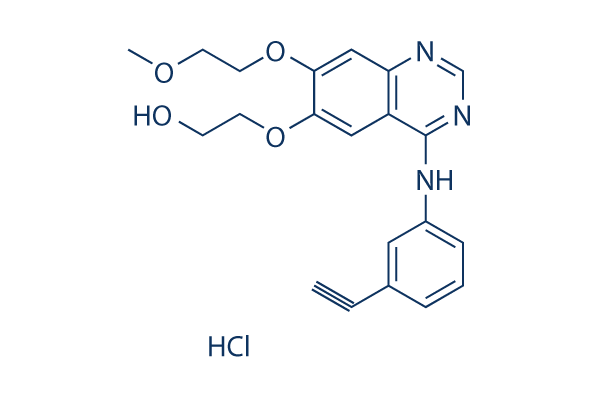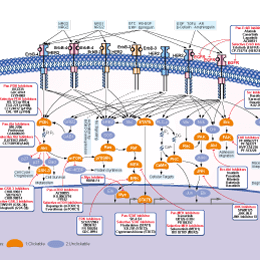
- Bioactive Compounds
- By Signaling Pathways
- PI3K/Akt/mTOR
- Epigenetics
- Methylation
- Immunology & Inflammation
- Protein Tyrosine Kinase
- Angiogenesis
- Apoptosis
- Autophagy
- ER stress & UPR
- JAK/STAT
- MAPK
- Cytoskeletal Signaling
- Cell Cycle
- TGF-beta/Smad
- DNA Damage/DNA Repair
- Compound Libraries
- Popular Compound Libraries
- Customize Library
- Clinical and FDA-approved Related
- Bioactive Compound Libraries
- Inhibitor Related
- Natural Product Related
- Metabolism Related
- Cell Death Related
- By Signaling Pathway
- By Disease
- Anti-infection and Antiviral Related
- Neuronal and Immunology Related
- Fragment and Covalent Related
- FDA-approved Drug Library
- FDA-approved & Passed Phase I Drug Library
- Preclinical/Clinical Compound Library
- Bioactive Compound Library-I
- Bioactive Compound Library-Ⅱ
- Kinase Inhibitor Library
- Express-Pick Library
- Natural Product Library
- Human Endogenous Metabolite Compound Library
- Alkaloid Compound LibraryNew
- Angiogenesis Related compound Library
- Anti-Aging Compound Library
- Anti-alzheimer Disease Compound Library
- Antibiotics compound Library
- Anti-cancer Compound Library
- Anti-cancer Compound Library-Ⅱ
- Anti-cancer Metabolism Compound Library
- Anti-Cardiovascular Disease Compound Library
- Anti-diabetic Compound Library
- Anti-infection Compound Library
- Antioxidant Compound Library
- Anti-parasitic Compound Library
- Antiviral Compound Library
- Apoptosis Compound Library
- Autophagy Compound Library
- Calcium Channel Blocker LibraryNew
- Cambridge Cancer Compound Library
- Carbohydrate Metabolism Compound LibraryNew
- Cell Cycle compound library
- CNS-Penetrant Compound Library
- Covalent Inhibitor Library
- Cytokine Inhibitor LibraryNew
- Cytoskeletal Signaling Pathway Compound Library
- DNA Damage/DNA Repair compound Library
- Drug-like Compound Library
- Endoplasmic Reticulum Stress Compound Library
- Epigenetics Compound Library
- Exosome Secretion Related Compound LibraryNew
- FDA-approved Anticancer Drug LibraryNew
- Ferroptosis Compound Library
- Flavonoid Compound Library
- Fragment Library
- Glutamine Metabolism Compound Library
- Glycolysis Compound Library
- GPCR Compound Library
- Gut Microbial Metabolite Library
- HIF-1 Signaling Pathway Compound Library
- Highly Selective Inhibitor Library
- Histone modification compound library
- HTS Library for Drug Discovery
- Human Hormone Related Compound LibraryNew
- Human Transcription Factor Compound LibraryNew
- Immunology/Inflammation Compound Library
- Inhibitor Library
- Ion Channel Ligand Library
- JAK/STAT compound library
- Lipid Metabolism Compound LibraryNew
- Macrocyclic Compound Library
- MAPK Inhibitor Library
- Medicine Food Homology Compound Library
- Metabolism Compound Library
- Methylation Compound Library
- Mouse Metabolite Compound LibraryNew
- Natural Organic Compound Library
- Neuronal Signaling Compound Library
- NF-κB Signaling Compound Library
- Nucleoside Analogue Library
- Obesity Compound Library
- Oxidative Stress Compound LibraryNew
- Plant Extract Library
- Phenotypic Screening Library
- PI3K/Akt Inhibitor Library
- Protease Inhibitor Library
- Protein-protein Interaction Inhibitor Library
- Pyroptosis Compound Library
- Small Molecule Immuno-Oncology Compound Library
- Mitochondria-Targeted Compound LibraryNew
- Stem Cell Differentiation Compound LibraryNew
- Stem Cell Signaling Compound Library
- Natural Phenol Compound LibraryNew
- Natural Terpenoid Compound LibraryNew
- TGF-beta/Smad compound library
- Traditional Chinese Medicine Library
- Tyrosine Kinase Inhibitor Library
- Ubiquitination Compound Library
-
Cherry Picking
You can personalize your library with chemicals from within Selleck's inventory. Build the right library for your research endeavors by choosing from compounds in all of our available libraries.
Please contact us at [email protected] to customize your library.
You could select:
- Antibodies
- Bioreagents
- qPCR
- 2x SYBR Green qPCR Master Mix
- 2x SYBR Green qPCR Master Mix(Low ROX)
- 2x SYBR Green qPCR Master Mix(High ROX)
- Protein Assay
- Protein A/G Magnetic Beads for IP
- Anti-Flag magnetic beads
- Anti-Flag Affinity Gel
- Anti-Myc magnetic beads
- Anti-HA magnetic beads
- Magnetic Separator
- Poly DYKDDDDK Tag Peptide lyophilized powder
- Protease Inhibitor Cocktail
- Protease Inhibitor Cocktail (EDTA-Free, 100X in DMSO)
- Phosphatase Inhibitor Cocktail (2 Tubes, 100X)
- Cell Biology
- Cell Counting Kit-8 (CCK-8)
- Animal Experiment
- Mouse Direct PCR Kit (For Genotyping)
- New Products
- Contact Us
DesMethyl Erlotinib (OSI-420) HCl
Synonyms: CP-473420
DesMethyl Erlotinib (OSI-420) HCl is the active metabolite of Erlotinib (EGFR inhibitor with IC50 of 2 nM).

DesMethyl Erlotinib (OSI-420) HCl Chemical Structure
CAS No. 183320-51-6
Purity & Quality Control
Batch:
Purity:
99.05%
99.05
DesMethyl Erlotinib (OSI-420) HCl Related Products
Signaling Pathway
Biological Activity
| Description | DesMethyl Erlotinib (OSI-420) HCl is the active metabolite of Erlotinib (EGFR inhibitor with IC50 of 2 nM). | ||
|---|---|---|---|
| Features | OSI 420 is a major active metabolite of Erlotinib. | ||
| Targets |
|
| In vitro | ||||
| In vitro | OSI-420 is the major metabolite of Erlotinib in human plasma. Erlotinib disappearance from plasma after a short IV infusion is biexponential with a mean terminal half-life of 5.2 h and a mean clearance of 128 ml/min per m(2). OSI-420 exposure (AUC) in plasma is 30% (range 12-59%) of erlotinib, and OSI-420 clearance is more than 5-fold higher than erlotinib. Erlotinib and OSI-420 are equipotent, and the combined concentrations of erlotinib + OSI-420 achieved in the CSF exceeded the IC50 (7.9 ng/ml or 20 nM) for the EGFR tyrosine kinase inhibition in intact tumor cells. [1] Erlotinib potently inhibits EGFR activation in intact cells including HNS human head and neck tumor cells (IC50 20nM), DiFi human colon cancer cells andMDA MB-468 human breast cancer cells. Erlotinib (1 μM) induces apoptosis in DiFi human colon cancer cells. [2] Erlotinib inhibits growth of a panel of NSCLC cell lines including A549, H322, H3255, H358 H661, H1650, H1975, H1299, H596 with IC50 ranging from 29 nM to >20 μM. [3] Erlotinib(2 μM) significantly inhibits growth of AsPC-1 and BxPC-3 pancreatic cells. [4] The effects of Erlotinib HCl in combination with gemcitabine are considered additive in KRAS-mutated pancreatic cancer cells. Ten micromolar of Erlotinib inhibits EGFR phospho-rylation at the Y845 (Src-dependent phosphorylation) and Y1068 (auto-phosphorylation) sites. [5] Combination with Erlotinib could down-modulate rapamycin-stimulated Akt activity and produces a synergistic effect on cell growth inhibition. [6] | |||
|---|---|---|---|---|
| Kinase Assay | Kinase Assays | |||
| 96-well plates are coated by incubation overnight at 37 °C with 100 μL per well of 0.25 mg/mL PGT in PBS. Excess PGT is removed by aspiration, and the plate is washed 3 times with washing buffer (0.1% Tween 20 in PBS). The kinase reaction is performed in 50 μL of 50 mM HEPES (pH 7.3), containing 125 mM sodium chloride, 24 mM magnesium chloride, 0.1 mM sodium orthovanadate, 20 μM ATP, 1.6 μg/mL EGF, and 15 ng of EGFR, affinity purified from A431 cell membranes. Erlotinib HCl in DMSO is added to give a final DMSO concentration of 2.5%. Phosphorylation is initiated by addition of ATP and proceeded for 8 minutes at room temperature, with constant shaking. The kinase reaction is terminated by aspiration of the reaction mixture and is washed 4 times with washing buffer. Phosphorylated PGT is measured by 25 minutes of incubation with 50 μL per well HRP-conjugated PY54 antiphosphotyrosine antibody, diluted to 0.2 μg/mL in blocking buffer (3% BSA and 0.05% Tween 20 in PBS). Antibody is removed by aspiration, and the plate is washed 4 times with washing buffer. The colonmetric signal is developed by addition of TMB Microwell Peroxidase Substrate, 50μL per well, and stopped by the addition of 0.09 M sulfuric acid, 50 μL per well. Phosphotyrosine is estimated by measurement of absorbance at 450 nm. The signal for controls is typically 0.6-1.2 absorbance units, with essentially no back ground in wells without AlP, EGFR, or PGT and is proportional to the time of incubation for 10 minutes. | ||||
| Cell Research | Cell lines | A549, H322, H3255, H358 H661, H1650, H1975, H1299, H596 cells | ||
| Concentrations | 30 nM-20 μM | |||
| Incubation Time | 72 hour | |||
| Method | Exponentially growing cells are seeded in 96-well plastic plates and exposed to serial dilutions of erlotinib, pemetrexed, or the combination at a constant concentration ratio of 4:1 in triplicates for 72 h. Cell viability is assayed by cell count and the 3-(4,5-dimethylthiazol-2-yl)-2,5-diphenyltetrazolium bromide assay. Growth inhibition is expressed as the percentage of surviving cells in drug-treated versus PBS-treated control cells (which is considered as 100% viability). The IC50 value is the concentration resulting in 50% cell growth inhibition by a 72-h exposure to drug(s) compared with untreated control cells and is calculated by the CalcuSyn software. |
|||
| In Vivo | ||
| In vivo | At doses of 100 mg/kg, Erlotinib completely prevents EGF-induced autophosphorylation of EGFR in human HN5 tumors growing as xenografts in athymic mice and of the hepatic EGFR of the treated mice. [1] Erlotinib reduces the growth of xenografted human AML cells. [4] | |
|---|---|---|
| Animal Research | Animal Models | Male 5-week-old BALB-nu/nu mice with HPAC |
| Dosages | 50 mg/kg | |
| Administration | Oral administration | |
| NCT Number | Recruitment | Conditions | Sponsor/Collaborators | Start Date | Phases |
|---|---|---|---|---|---|
| NCT00124657 | Completed | Brain and Central Nervous System Tumors |
St. Jude Children''s Research Hospital|Rady Children''s Hospital San Diego|Duke University |
March 2005 | Phase 1|Phase 2 |
Chemical Information & Solubility
| Molecular Weight | 415.87 | Formula | C21H21N3O4.HCl |
| CAS No. | 183320-51-6 | SDF | Download DesMethyl Erlotinib (OSI-420) HCl SDF |
| Smiles | COCCOC1=C(C=C2C(=C1)N=CN=C2NC3=CC=CC(=C3)C#C)OCCO.Cl | ||
| Storage (From the date of receipt) | |||
|
In vitro |
DMSO : 83 mg/mL ( (199.58 mM) Moisture-absorbing DMSO reduces solubility. Please use fresh DMSO.) Water : Insoluble Ethanol : Insoluble |
Molecular Weight Calculator |
|
In vivo Add solvents to the product individually and in order. |
In vivo Formulation Calculator |
||||
Preparing Stock Solutions
Molarity Calculator
In vivo Formulation Calculator (Clear solution)
Step 1: Enter information below (Recommended: An additional animal making an allowance for loss during the experiment)
mg/kg
g
μL
Step 2: Enter the in vivo formulation (This is only the calculator, not formulation. Please contact us first if there is no in vivo formulation at the solubility Section.)
% DMSO
%
% Tween 80
% ddH2O
%DMSO
%
Calculation results:
Working concentration: mg/ml;
Method for preparing DMSO master liquid: mg drug pre-dissolved in μL DMSO ( Master liquid concentration mg/mL, Please contact us first if the concentration exceeds the DMSO solubility of the batch of drug. )
Method for preparing in vivo formulation: Take μL DMSO master liquid, next addμL PEG300, mix and clarify, next addμL Tween 80, mix and clarify, next add μL ddH2O, mix and clarify.
Method for preparing in vivo formulation: Take μL DMSO master liquid, next add μL Corn oil, mix and clarify.
Note: 1. Please make sure the liquid is clear before adding the next solvent.
2. Be sure to add the solvent(s) in order. You must ensure that the solution obtained, in the previous addition, is a clear solution before proceeding to add the next solvent. Physical methods such
as vortex, ultrasound or hot water bath can be used to aid dissolving.
Tech Support
Answers to questions you may have can be found in the inhibitor handling instructions. Topics include how to prepare stock solutions, how to store inhibitors, and issues that need special attention for cell-based assays and animal experiments.
Tel: +1-832-582-8158 Ext:3
If you have any other enquiries, please leave a message.
* Indicates a Required Field
Tags: buy DesMethyl Erlotinib (OSI-420) HCl | DesMethyl Erlotinib (OSI-420) HCl supplier | purchase DesMethyl Erlotinib (OSI-420) HCl | DesMethyl Erlotinib (OSI-420) HCl cost | DesMethyl Erlotinib (OSI-420) HCl manufacturer | order DesMethyl Erlotinib (OSI-420) HCl | DesMethyl Erlotinib (OSI-420) HCl distributor







































